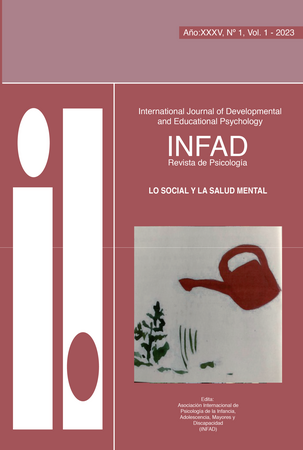Propiedades psicométricas des test breve de empatía para niños mexicanos
Contenido principal del artículo
Resumen
La empatía es una de las habilidades más cruciales para el desarrollo de niños y adolescentes. La capacidad de “sentir o experimentar” las emociones de otras personas se denomina empatía. Es una habilidad que promueve la adherencia y la adaptabilidad al grupo familiar y social y favorece el adecuado funcionamiento del individuo, la empatía también es vista como un método positivo de comunicación. Método: El proceso de creación de este instrumento se inició con una revisión de la literatura. A partir de un primer borrador de 88 ítems, se creó un banco de ítems y se pidió a los jueces (psicólogos con experiencia en psicometría, psicología infantil y el tema de la empatía) que evaluarán los resultados. De manera similar, estos primeros elementos se presentaron a un grupo focal de niños para ver si entendían las oraciones dadas sus edades. Posteriormente, se sacaron las preguntas que no estaban claras en su redacción, que los niños no entendieron o que no recibieron la aprobación de los jueces. Luego se agregó y utilizó una versión breve con 29 ítems para el análisis psicométrico. Resultados: El Test Breve de Empatía para Niños es un cuestionario autoadministrado, con 29 ítems con respuestas en una escala tipo Likert que incluye nunca, a veces y siempre. Aplicable a niños de 8 a 13 años. Tiene cuatro subescalas: 1) Angustia Compasiva (AC) con 11 ítems, 2) Fantasía Empática (FE) con 4 ítems, 3) Toma de Perspectiva (TP) con 6 ítems, y 4) Comprensión Empática (UE) con 8 ítems. Discusión: Un nivel de empatía alto en niños repercutirá de manera positiva en el desarrollo y se puede observar en sus relaciones interpersonales y solución de conflictos.
Detalles del artículo
Sección

Esta obra está bajo una licencia internacional Creative Commons Atribución-NoComercial-SinDerivadas 4.0.
Aquellos autores/as que tengan publicaciones con esta revista, aceptan los términos siguientes:
- Los autores/as conservarán sus derechos de autor y garantizarán a la revista el derecho de primera publicación de su obra, el cuál estará simultáneamente sujeto a la Licencia de reconocimiento de Creative Commons que permite a terceros copiar y redistribuir el material en cualquier medio o formato bajo los siguientes términos: —se debe dar crédito de manera adecuada, brindar un enlace a la licencia, e indicar si se han realizado cambios. Puede hacerlo en cualquier forma razonable, pero no de forma tal que sugiera que usted o su uso tienen el apoyo de la licenciante (Atribución); — no se puede hacer uso del material con propósitos comerciales (No Comercial); — si se remezcla, transforma o crea a partir del material, no podrá distribuirse el material modificado (Sin Derivadas).
- Los autores/as podrán adoptar otros acuerdos de licencia no exclusiva de distribución de la versión de la obra publicada (p. ej.: depositarla en un archivo telemático institucional o publicarla en un volumen monográfico) siempre que se indique la publicación inicial en esta revista.
- Se permite y recomienda a los autores/as difundir su obra a través de Internet (p. ej.: en archivos telemáticos institucionales o en su página web) antes y durante el proceso de envío, lo cual puede producir intercambios interesantes y aumentar las citas de la obra publicada. (Véase El efecto del acceso abierto).

Este obra está bajo una licencia de Creative Commons Reconocimiento-NoComercial-SinObraDerivada 4.0 Internacional.
Cómo citar
Referencias
Davis, MH (1996). Un enfoque psicológico social. Prensa de Westview
Dohrenwend, A., (2018). Definir la empatía para enseñar, medir y comprender mejor su impacto. Medicina Académica, 93(12), 1754-1756.
Dymond, RF (1949). Una escala para la medida de la capacidad empática. Revista de Psicología Consultora, 13(2), 127–133. https://doi.org/10.1037/h0061728
Eisenberg, N. y Miller, PA (1987). La relación de la empatía con los comportamientos prosociales y relacionados. Boletín Psicológico, 101(1), 91–119. https://doi.org/10.1037/0033-2909.101.1.91
Fernández-Pinto, I., López-Pérez, B. & Márquez, M. (2008). Empatía: Medidas, teorías y aplicaciones en revisión. Revista Anales de Psicología, 24 (2), 284-298.
Ferrando, PJ y Lorenzo-Seva, U. (2017). Programa FACTOR a las 10: Orígenes, desarrollo y direcciones futuras. Psicothema, 29(2), 236–240. https://doi.org/10.7334/psicothema2016.304
Garaigordobil, M., & De Galdeano, P. G. (2006). Empatía en niños de 10 a 12 años. Psicothema, 18(2), 180-186.
Hogan, R. (1969). Elaboración de una escala de empatía. Revista de consultoría y psicología clínica, 33(3), 307.
Igartua, PJ y Páez, RD (1998). Validez y confianza de una escala de empatía e identificación con los personajes, Psicothema, 10(2), 423-436.
Ledesma-Amaya, L., Cruz, RG, Guzmán-Saldaña, R., & Lilian, LBB (2022). Evaluación de la Teoría de la Mente en Adolescentes. Universidad y Sociedad, 14(3), 395-402.
Ledesma-Amaya, L., Galindo-Aldana, G., Gálvez, V., Salvador-Cruz, J., & Guzmán-Saldaña, R. (en prensa, 2023). Validación de un breve Test de Cociente de Empatía con adolescentes de México. Psicología del Comportamiento, 31 (1)
Lipps, T. (1903). Estética. Psychologie des Schönen und der Kunst. Voss.
Lloret-Segura, S., Ferreres-Traver, A., Hernández-Baeza, A., & Tomás-Marco, I. (2014). El análisis factorial exploratorio de los ítems: una guía práctica, revisada y actualizada. Anales de Psicología / Annals of Psychology, 30(3), 1151–1169. https://doi.org/10.6018/analesps.30.3.199361
.
Matamoros, N. (2000). Hermenéutica de moda, comunicación y empatía. Analogía filosófica: revista de filosofía, investigación y difusión, 14(7), 1-8.
Aguamiel, GH (1934). Mente, yo y sociedad desde el punto de vista de un conductista social. Prensa de la Universidad de Chicago: Chicago.
Otiz, MJ, Apodaka, P., Etxeberria, I., Ezeiza, A., Fuentes, MJ, & López, F. (1993). Algunos predictores de la conducta prosocial-altruista en la infancia: empatía, toma de perspectiva, apego, modelos parentales, disciplina familiar e imagen del ser humano. Revista de Psicología Social, 8(1), 83-98.
Ruiz Silva, A., Chaux Torres, E. (2005). La formación de competencias ciudadanas. Bogotá: Ascofade
Salovey P. y Mayer, JD (1989-1990). Inteligencia emocional. Imaginación, Cognición y Personalidad, 9, (3) 185-211.
Titchener, EB (1909). Conferencias sobre la psicología experimental de los procesos de pensamiento. Compañía MacMillan https://doi.org/10.1037/10877-000

